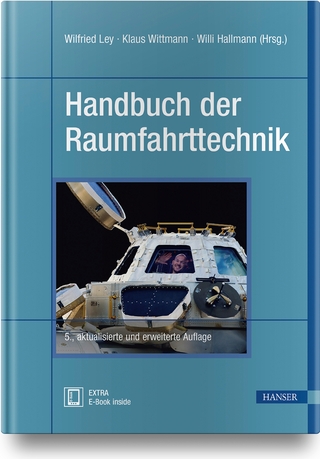
Handbook of Life Support Systems for Spacecraft and Extraterrestrial Habitats
Springer International Publishing (Verlag)
978-3-319-10457-7 (ISBN)
- Noch nicht erschienen (ca. Juli 2025)
- Versandkostenfrei innerhalb Deutschlands
- Auch auf Rechnung
- Verfügbarkeit in der Filiale vor Ort prüfen
- Artikel merken
Dr. Erik Seedhouse worked as an Astronaut Training Consultant for Bigelow Aerospace in 2005, a company for whom he wrote the Spaceflight Participants Flight Surgeon’s Manual, and also prepared many reports and oversaw training in his years with the DRDC. Erik is a research scientist specializing in environmental life sciences and physiology, the subject in which he obtained his Ph.D. in Physiology while working for the European Space Agency between 1996 and 1998. In 2009, he was one of the final candidates for selection as an astronaut in the CSA’s Astronaut Recruitment Campaign. He is a certified commercial suborbital astronaut who will fly a payload mission in 2014. He is also Training Director for Astronauts for Hire and, for the last four years, served as Director of Canada’s Manned Centrifuge Operations.
Characteristics of a Vacuum Effects of Reduced Gravity Characteristics of Galactic Cosmic and Solar Radiation Hazards of Space Debris Lunar Environment, Overview Martian Environment, Overview Characteristics of the Martian Surface Human Factors Requirements Maintaining Crew Bone Health Maintenance of a Breathable Atmosphere, Temperature and Water Supply Manned Spaceflight Waste Management Minimizing Muscle Atrophy Protecting Crew from Decompression Protecting Crews from Radiation using Pharmacological Countermeasures Short and Long Duration Mission Human Factors Requirements Spaceflight Nutritional Support Classification and Overview of Spacecraft Life Support Systems Russian Life Support Systems: Vostok, Voskhod, and Soyuz Early American Life Support Systems: Mercury, Gemini and Apollo Russian Life Support Systems of the 1970s and 1980s: Salyut and Mir Recent American Life Support Systems: Skylab, Spacelab, and the Shuttle Life Support Systems of the International Space Station Current Life Support Systems of the 2000s: Orion, Dragon Essentials of Life Support Systems: Carbon Dioxide Scrubbing Extravehicular Activity, Overview Extravehicular Activity Prebreathe Protocols Landing and Post-Landing Considerations for Manned Space Missions Artificial Intelligence for Life Support Maintenance and Repair Commercial Life Support Systems Hibernation and Torpor: Prospects for Human Spaceflight Extravehicular Requirements: Lunar and Mars Future Life Support Systems, Overview Hibernation Entry Procedures In-space Maintenance and Repair of Life Support Systems Life Support Systems for Manned Mars Missions, Overview Lunar Life Support Requirements and Characteristics Bioprinting Mars One Mission and Base Requirements Waste Management, Solid Waste Treatment Water Walls, Overview Water Walls: Subsystems and Components Monitoring Biometrics in Spaceflight Common Examples of Physico-Chemical Systems Installed Aboard Submarines Examples of Physico-Chemical Life Support Systems: International Space Station High Pressure and Cryogenic Storage Methods of Water Management, Water Recovery, and Quality Monitoring Algal and Microbial Systems Bioregenerative Life Support Systems, Overview Modeling and Design of Bioregenerative Life Support Systems System Challenges Effects of Space on Biological Plant Processes: Gravity and Radiation Biological Experiments in Space: NASA Biological Experiments in Space: ESA Biological Experiments in Space: Russia Designing a Closed Ecological Life Support System for Plants, Overview Growth Area, Growth Media, Hydroponics, Aeroponics and Zeoponics Crop Selection in Controlled Ecological Life Support Systems Water Recovery and Waste Processing Animals as Food Aquaculture Systems Food Management and Processing: Production, Storage and Processing Crew Time/Monitoring Autonomous Monitoring Systems/Intelligent Control/AI Atmosphere, Temperature, Humidity and Lighting Requirements EDEN ISS: A Plant Cultivation Technology for Spaceflight Biological Experiments in Space, China Space Suits and Life Support: Basic Concepts of IVA vs. EVA Mechanical Counter Pressure Life Support Systems for Russian IVA/EVA Space Suits Working Outside a Spacecraft or Space Habitat Extra-Vehicular Mobility Units, Overview Design Requirements EVA Suit Operations Airlock Design and Operations Lessons Learned from Previous and Current Spacesuit Designs Spacesuits in Development and Future Trends Future Trends in Spacesuit Design: The Biosuit EVA Propulsion and Mobility Non-Suited EVA Commercial Suit Providers US Space Suits Bios-1, 2 and 3 Closed Ecology Experiment Facility (CEEF): Research and Lessons Learned Controlled Environment Systems Research Facility (CESRF) CESRF Habitat, Research and Lessons Learned Mars Academy USA Analog Training MDRS Lessons Learned Survivability and Adaptation of Humans to Long-Duration Exploratory Missions (HUMEX), Overview HUMEX Reference Mission Design, Research and Lessons Learned Micro-Ecological Life Support Alternative (MELISSA), Overview MELISSA Phase by Phase, Research and Lessons Learned MARS500 and 105, Overview NASA Extreme Environment Mission Operations (NEEMO), Overview Aquarius Habitat NASA Extreme Environment Mission Operations (NEEMO): Fields of Life Support Research Advanced Life Support University Centers, Overview Env Systems Commercial Space Technology Center at the University of Florida Biosphere II Habitat, Research and Lessons Learned Logistics of Reproduction in Space Psychosocial Resilience
| Erscheint lt. Verlag | 27.7.2025 |
|---|---|
| Mitarbeit |
Chef-Herausgeber: David J Shayler |
| Zusatzinfo | 1000 p. 300 illus., 200 illus. in color. In 2 volumes, not available separately. |
| Verlagsort | Cham |
| Sprache | englisch |
| Maße | 155 x 235 mm |
| Themenwelt | Technik ► Luft- / Raumfahrttechnik |
| Schlagworte | Atmosphere Management • Atmospheric Control and Supply Systems • Bioregenerative Life Support Systems • Closed Ecological Life Support System for Plants • Commercial Life Support Systems • Galactic Cosmic Radiation • Human Habitability Considerations • Mission Simulations for Solar System Exploration • Requirements for Human Space Exploration • Spacesuits in Development |
| ISBN-10 | 3-319-10457-8 / 3319104578 |
| ISBN-13 | 978-3-319-10457-7 / 9783319104577 |
| Zustand | Neuware |
| Haben Sie eine Frage zum Produkt? |
aus dem Bereich


